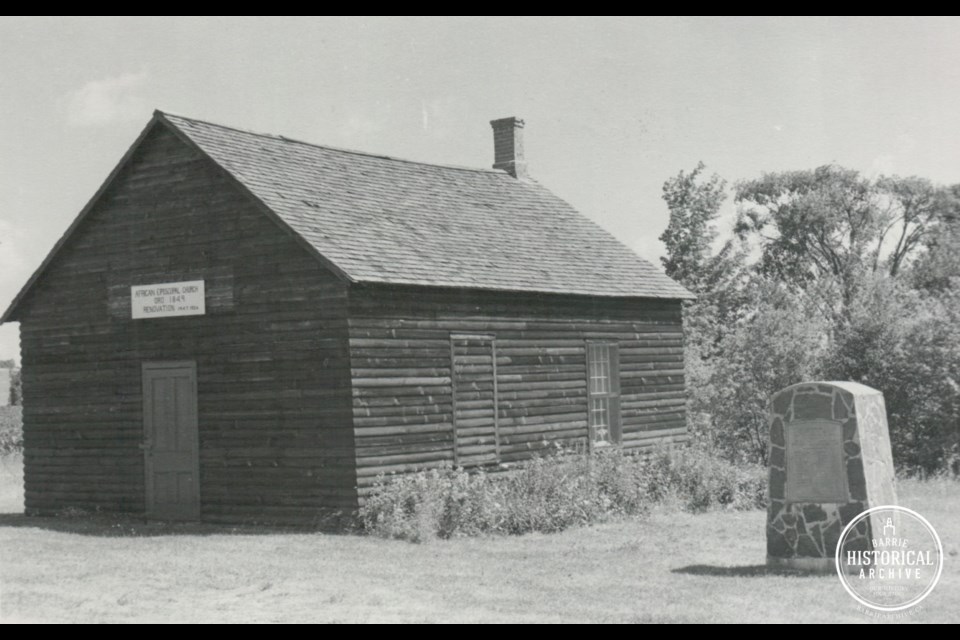This ongoing series from Barrie Historical Archive curator Deb Exel shows old photos from the collection and one from the present day, as well as the story behind them.
Oro African Methodist Episcopal Church
It’s not in Barrie, but it’s not far.
At the intersection of the Old Barrie Road and the 3rd Line of Oro is perhaps the oldest remaining African log church on the continent.
The church was built in the 1840s (it’s official anniversary date is 1849) by the earliest Black settlers to Canada and families of soldiers who served in an all-Black militia during the War of 1812.
Yup, this important piece of history is right in our backyard.
The Barrie Historical Archive’s resident storyteller Mary Harris wrote an account of one of these militiamen, George, who had been born into slavery in Virginia about 1769. He came to Canada prior to 1812 and was a member of Runchey’s Company of Coloured Men, a corps of Black soldiers. Read this touching story here.
The Oro church was initially built of logs, but after about 10 years, clapboard was added to keep out the wind and the cold.
The founding congregation stopped actively worshipping in the church sometime in the 1920s. By the 1940s, the church was in very poor condition. Concerned by the potential loss of this historic site, descendants of the founders and local residents triggered what has become almost 75 years of ongoing conservation of this cherished landmark.
Renovations were kicked off by teacher W.R. Best and Ontario Premier E.C. Drury in time for the 100th anniversary of the church.
Our ‘Then’ photo, taken about 1966, reflects the renovations that occurred in 1947 and 1954.
The little church was declared abandoned in 1977 and the Township of Oro-Medonte stepped in and took it over. In spite of being designated a National Historic Site in 2000, the church had fallen into disrepair again.
The township had a cultural heritage assessment conducted in 2013 to determine the condition of the site and to develop a plan for its preservation.
Fortunately, a project came together and restoration was underway in 2015. Major work was required to stabilize the floor, reinforce the original ceiling joists, add new cedar shingles and replace clapboard.
Wherever possible, original building materials were left in or returned to their original position. This included keeping the not-completely-square walls and windows, along with the uneven roof line, so the church appeared as the aged building it is.
Restoration workers also made the most incredible discovery. Some of the chinking from the old log walls, complete with the fingerprints of one the original construction workers in the dried mud, was recovered.
In late-2017, the Barrie Historical Archive invited Mike Rekker, part of the Tacoma Engineers team that worked on the restoration, to give a presentation and speak about his experience.
Rekker told us this week:
“The restoration of the Oro African Church is one of my favourite projects that I was involved with and I am always excited and proud to talk about it. The project was a great example of a community coming together to celebrate local history in restoring a boarded 1840s log building to something everyone involved can be proud of. From the initial awareness campaign to its grand opening, none of it would have happened without the many volunteers, donations and local support.
"It was interesting to hear and read public feedback through the process as restoration of heritage structures can often be scrutinized. The proposed restoration solutions had to address the reason for the structures deterioration," he added. "This identified how critical it was to address ‘why’ when completing the work.
"To watch the relocation of a fragile structure to its new foundation, the log wall replacement and repair, the re-cladding of the exterior walls, roofing replacement and many other provisions to maintain the building. It was a labour of both professional and personal interest and a great heritage building success story.”
The opening ceremonies for the restored African Church were held in August 2016 and, pre-COVID, tours of this humble yet remarkable heritage building are offered.
Even if you can’t get inside for a look right now, it’s still worth a drive to Oro to visit this survivor from the past and reflect on the church’s importance in history.


